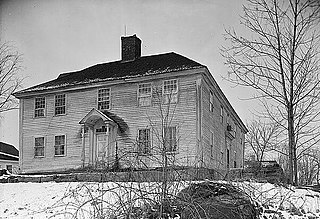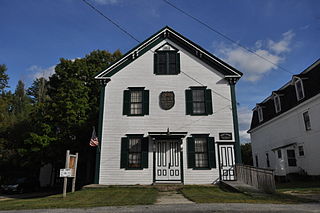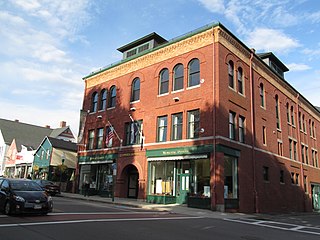
The Tennessee Theatre is a movie palace in downtown Knoxville, Tennessee. The theater was built in 1928 in the 1908 Burwell Building, considered Knoxville's first skyscraper. The theater and Burwell Building were added to the National Register of Historic Places in 1982, and the theater was extensively restored in the early 2000s. The Tennessee Theatre currently focuses on hosting performing arts events and classic films, and is home to the Knoxville Opera and the Knoxville Symphony Orchestra. The theater is managed by AC Entertainment.

The Michigan Theater is a movie palace in Ann Arbor, Michigan, United States. It shows independent films and stage productions, and hosts musical concerts.

The Rowland Theater, located at 127 North Front Street, Philipsburg, Centre County, Pennsylvania, United States, is an historic single screen movie theater, built in 1917 by Charles Hedding Rowland. The theater is owned by the borough of Phillipsburg.

Cumston Hall is a historic community building at 796 Main Street in downtown Monmouth, Maine. Built in 1900, it is one of the most flamboyant examples of wooden Romanesque Revival architecture to be found in a small-town setting in the entire state. It was a gift to the town of Dr. Charles M. Cumston, and presently houses the local public library and local theatrical companies. It was listed on the National Register of Historic Places in 1973.

The Ramsdell Theatre is a historic playhouse theater building and opera house at 101 Maple Street in downtown Manistee, Michigan. The building was financed by local businessman and politician Thomas Jefferson Ramsdell. At the time the structure was built in 1902, it was considered one of the best opera and vaudeville buildings in the United States. It replaced the town's two previous opera houses which had been destroyed by fire, one in 1882 and the other in 1900. Besides producing plays the facility was later used as a movie theater. James Earl Jones started his acting career at the theater.

The Porter County Memorial Hall, also known as Memorial Opera House, is an historic Grand Army of the Republic memorial hall located in Valparaiso, Indiana. It was the meeting place of Chaplain Brown GAR Post No. 106, one of 592 GAR posts in Indiana. Designed in 1892 by a local architect, Charles F. Lembke., using Romanesque styling, it was built in 1892-3 to seat 100 people. It was also used as the local opera house.

The Pythian Opera House, also known historically as the Knights of Pythias Hall, Boothbay Harbor Opera House and The Opera House, and formally as The Opera House at Boothbay Harbor, is a historic meeting hall and multifunction building at 86 Townsend Avenue in Boothbay Harbor, Maine. Built in 1894, it has housed government offices of the town, and the meeting spaces of fraternal organizations, prior to its present use as a performance venue. It was listed on the National Register of Historic Places on December 30, 2008.

The Littleton Town Building, also known as the Littleton Opera House, is a historic municipal building at 1 Union Street in Littleton, New Hampshire. Built on a steep embankment overlooking the Ammonoosuc River in 1894-5, it is a good example of a Late Victorian municipal building, which continues to serve that purpose today. The building was listed on the National Register of Historic Places in 1973.

The North Stonington Village Historic District is a 105-acre (42 ha) historic district encompassing the historic center of the main village of North Stonington, Connecticut. The district includes a well-preserved small industrial village, which flourished in the years before the American Civil War, and declined afterward. The district was listed on the National Register of Historic Places in 1983.

The Thomaston Opera House is a historic performance venue and the town hall of Thomaston, Connecticut. Located at 153 Main Street, it was built in 1883-85, and is a good local example of Romanesque architecture. The theater in the building has served as a performance and film venue since its construction. It was listed on the National Register of Historic Places in 1972. The opera house's principal tenant is now the Landmark Community Theatre.

The Enterprise Grange, No. 173 is a historic Grange hall at 446 Dow Road in Orrington, Maine. Built in 1884 and enlarged in the early 20th century, this modest Italianate building has been a significant social and civic center in the rural community since its construction. It was listed on the National Register of Historic Places in 2008.

The Old Town Hall is a historic public building on Chester Green in Chester, Connecticut. Built in 1793 and subsequently altered and enlarged, it has been a significant civic meeting point for the community since its construction, hosting religious services, town meetings, and theatrical productions. It was listed on the National Register of Historic Places in 1972.

The Wheeler Opera House is located at the corner of East Hyman Avenue and South Mill Street in Aspen, Colorado, United States. It is a stone building erected during the 1890s, from a design by Willoughby J. Edbrooke that blends elements of the Romanesque Revival and Italianate architectural styles. In 1972 it became the first property in the city to be listed on the National Register of Historic Places, and the second in Pitkin County. The upstairs auditorium hosts a number of events every year, ranging from nationally prominent music and comedy acts and some of the Aspen Music Festival's events to productions by local community groups.

The Grand is a Non-Profit performing arts center on Main Street in Ellsworth, Maine). Built in 1938, it is a significant local example of Art Deco architecture, with a prominent marquee and a stepped steel-and-glass tower. It was listed on the National Register of Historic Places on August 1, 2012.

The Former Greenwood Town Hall is located at 270 Main Street in Locke Mills, the main village of Greenwood, Maine. Completed in 1931, the building has been a center of civic and social activities since, hosting town meetings, elections, school graduations, dances, and private functions. It was replaced as town hall by the present facilities in 1988, and is now maintained by a local non-profit. It was listed on the National Register of Historic Places in 2001.

The West Paris Lodge No. 15, I.O.O.F. is a historic fraternal clubhouse at 221 Main Street in West Paris, Maine. It was built during 1876-80 by the local chapter of the International Order of Odd Fellows (IOOF), and served as the meeting place for the fraternal organization into the 1980s. It is also a significant meeting space for social events in the wider community. The building, now owned by the local historical society, was listed on the National Register of Historic Places in 2012.

The Camden Opera House Block is a historic multifunction building at 29 Elm Street in the center of Camden, Maine, United States. Built in 1893 after the town's great 1892 fire, it is one of its most prominent buildings. It houses town offices, a social meeting hall, and a 500-seat theater. The building was listed on the National Register of Historic Places in 1986.

The Strand Theatre is a historic performing arts venue at 345 Main Street in downtown Rockland, Maine. Built in 1923 in the wake of a fire that destroyed part of the downtown, it is a rare example of Egyptian Revival architecture, and the only one of three theaters built in Rockland in that period to survive. Now owned by a non-profit, it continues to present films as well as musical and theatrical productions. It was listed on the National Register of Historic Places in 2004.

The Old Town House, also known as the Union Town House, is a historic government building at 128 Town House Road in Union, Maine. Built in 1840, it served the town for many years as its town hall, and as one of its major social venues. It is now owned by the local historical society, which operates it as a community meeting place. It was listed on the National Register of Historic Places in 2001.

The Waterville Opera House and City Hall is a historic civic building at Castonguay Square in downtown Waterville, Maine. Built at the turn of the 20th century, it is one of a small number of multifunction civic buildings, housing both a live performance venue and municipal facilities, functions it continues to perform today. It was listed on the National Register of Historic Places in 1976.






















